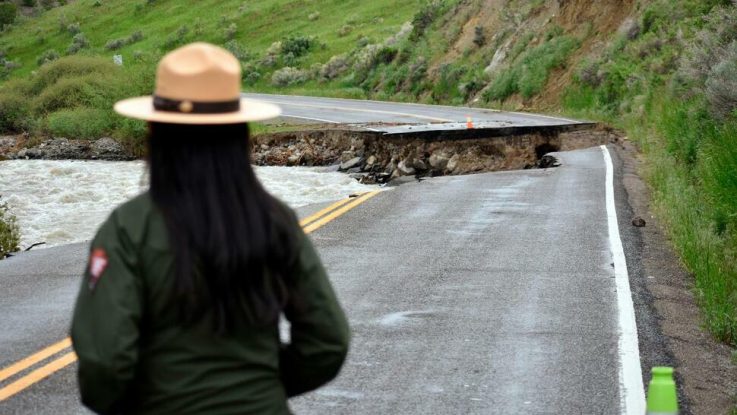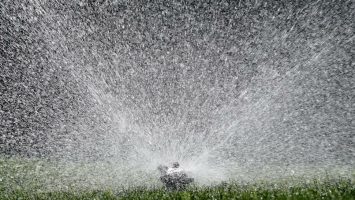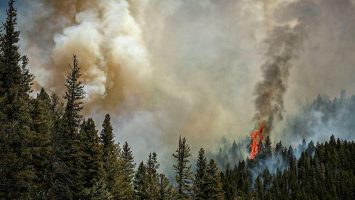
By MATTHEW BROWN and AMY BETH HANSON, Associated Press
GARDINER, Mont. (AP) — Most of Yellowstone National Park ought to return inside the following fourteen days — a lot quicker than initially expected after record floods beat the district last week and took out significant streets, government authorities said.
Yellowstone Superintendent Cam Sholly said the widely acclaimed park will actually want to oblige less guests until further notice, and it will require greater investment to reestablish street associations with some southern Montana people group.
Park authorities said Sunday they’ll involve $50 million in government expressway cash to accelerate street and scaffold fixes. There’s still no schedule for fixes to courses between the recreation area and areas of Montana where the recuperation is supposed to extend for a really long time.
Yellowstone will somewhat resume at 8 a.m. Wednesday, over seven days after in excess of 10,000 guests were constrained out of the recreation area when the Yellowstone and different waterways went over their banks in the wake of being expanded by dissolving snow and a few creeps of precipitation.
Just divides of the recreation area that can be gotten to along its “southern circle” of streets will be opened at first and admittance to the recreation area’s grand boondocks will be for day explorers as it were.
In no less than about fourteen days authorities plan to likewise open the northern circle, after already pronouncing that it would probably remain shut through the mid year season. The northern circle would give guests admittance to famous attractions including Tower Fall and Mammoth Hot Springs. They’d in any case be banned from the Lamar Valley, which is popular for its productive natural life including bears, wolves and buffalo that can frequently be seen from the side of the road.
“That would get 75 to 80% of the recreation area back to working,” National Park Service Director Charles “Hurl” Sams expressed Sunday during a visit to Yellowstone to check the flood’s belongings.
It will take significantly longer — conceivably years — to completely reestablish two gravely harmed stretches of street that connect the recreation area with Gardiner toward the north and Cooke City toward the upper east.
During a visit through harmed regions on Sunday, park authorities showed correspondents one of six segments of street close to Gardiner where the furious floodwaters demolished the majority of the street.
Sloppy water presently flows through where the roadbed had been just seven days prior. Trunks of immense trees litter the encompassing gulch.
Without any opportunities for a prompt fix, Sholly said 20,000 tons of material were being pulled in to build an impermanent, backup way to go along an old street that runs over the gully. That would give representatives who work at the recreation area base camp access Mammoth get to their homes in Gardiner, Sholly said. The brief course likewise could be utilized by business visit organizations that have grants to lead directed visits.
“We’ve accomplished significantly more than we suspected we would seven days prior,” Sholly said. “Being a mid year of adjustments is going.”
The extent of the harm is as yet being counted by Yellowstone authorities, however in light of other public park fiascos, it could require years and convey a precarious sticker price to modify in a naturally delicate scene — with an immense underground pipes framework — where development season just runs from the spring defrost until the primary snowfall.
“They’ll need to take a gander at everything the assets the recreation area is intended to secure, and attempt to do this venture as cautiously as could be expected, but at the same time they will attempt to go decently fast,” said Brett Hartl, government undertakings chief at the Center for Biological Diversity.
Montana areas have likewise been looking over their harms.
A portion of those hardest hit in the debacle — a long way from the renowned park’s spotlight — are inclining vigorously on each other to haul their lives out of the mud.
In and around the horticultural local area of Fromberg, the Clarks Fork River overflowed very nearly 100 homes and gravely harmed a significant water system ditch that serves many ranches. The town’s city hall leader says regarding 33% of the overwhelmed homes are excessively far gone to be fixed.
In Red Lodge, almost 150 homes were harmed or annihilated after Rock Creek got away from its banks a week ago.
In Park County — which incorporates Livingston, Gardiner and Cooke City — a fundamental evaluation of 437 designs found three homes were obliterated, 76 had moderate to significant harm and another 126 had minor harm. Eight extensions and seven streets were obliterated, while 16 business structures experienced moderate to significant harm, authorities said.
Stillwater County authorities were all the while counting the harm there on Monday, following weighty downpours toward the end of the week that made the waterways rise once more, said Rich Cowger, the fire boss in Columbus.
One house at the conjunction of Rosebud Creek and the Stillwater River close to Absarokee stayed undermined on Monday, Cowger said.
“Assuming that that house goes out, it’s an immediate danger to district framework,” he said. Individuals likewise need to eliminate logjams upstream, yet that could likewise make downstream issues, he said.




Leave a Reply